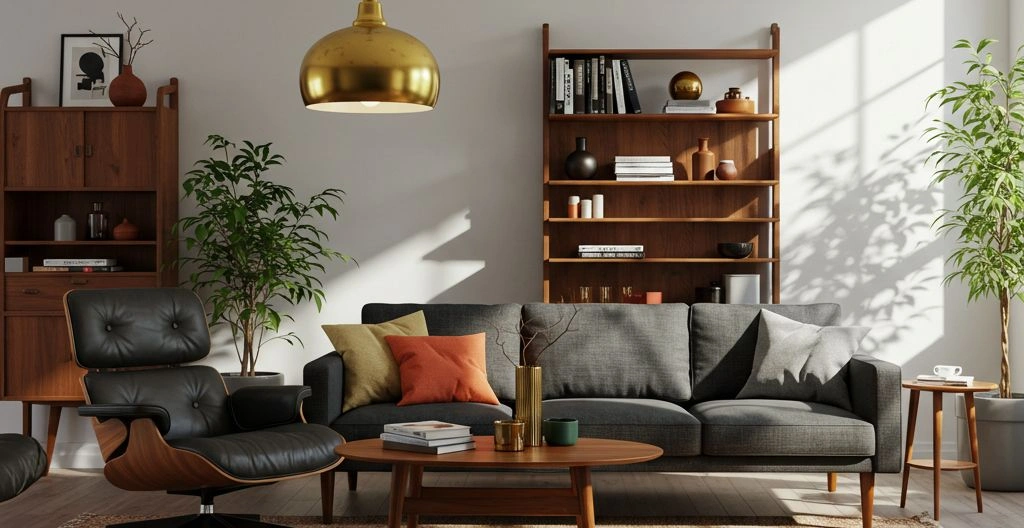The mid-century modern design brings timeless appeal through clean lines and warm materials, while the contemporary style focuses on present-day trends and simplicity. These two styles might seem different at first glance, but they can work together beautifully.
In this article, we’ll explore how to seamlessly merge mid-century modern furniture with contemporary spaces. By understanding the core elements of each style and applying thoughtful design choices, you can create a living space that feels both fresh and familiar.
What is Mid-Century Modern Style?
Mid-century modern design took shape between the 1930s and 1960s, after World War II. People wanted simpler, more practical homes and furniture, moving away from fancy traditional styles. They preferred clean lines and shapes inspired by nature.
The furniture from this era stands out with its distinctive features. You’ll notice tapered legs and low-sitting pieces made from natural materials. Woods like teak, walnut, and rosewood were often paired with glass, metal, and modern plastics to create timeless pieces that still look fresh today.
What is Contemporary Style?
Contemporary design is different from Mid-Century Modernism because it isn’t tied to a specific historical period. It reflects the current trends and is constantly evolving.
While contemporary design incorporates elements from various periods, like modernism and minimalism, its core features include clean lines, simplicity, and a spacious feel. Neutral tones, such as white, grey, and beige, form the foundation, with color added through artwork or statement furniture pieces.
One of the main features of contemporary style is the use of materials like metal, glass, concrete, and sustainable options. These materials add texture and depth, reflecting today’s focus on eco-friendly choices.
How Do You Incorporate Mid-Century Modern into a Contemporary Space?
The successful integration of mid-century modern furniture into a modern space often depends on a strategic room-by-room design approach that carefully considers how elements of each style complement one another in different areas of the home.
Living Room
In the living room, your goal is to create a cohesive focal point that combines mid-century modern warmth with contemporary design elements.
A statement mid-century modern sofa or armchair can anchor your space with its unique shape and warm wooden details. Balance this classic piece with a modern glass or metal coffee table to keep the area feeling fresh and open.
Mix materials wisely to maintain visual harmony. A mid-century sideboard works well with a glass side table, while metal shelving adds contemporary flair.
For your media setup, choose a simple television stand with clean lines or floating shelves that complement your MCM furniture. Add soft, modern touches with neutral-colored blankets and cushions to make your mid-century pieces more inviting.
Dining Room
The dining room offers a perfect chance to blend different design periods. Try pairing a warm, wooden mid-century modern table with sleek contemporary chairs, or flip the combination. This mix creates visual interest without overwhelming space.
Lighting helps tie these styles together. A modern metallic pendant lamp can hover above your MCM table, or you might choose a vintage-style fixture to accent your contemporary dining set.
Bedroom
In the bedroom, combining mid-century modern with contemporary design creates a peaceful, sophisticated space. Start with a modern bed that has clean lines, paired with mid-century modern nightstands featuring tapered legs and warm wood tones. A mid-century modern platform bed can be complemented with neutral-toned bedding and abstract wall art.
Adding a mid-century armchair in the corner provides retro charm and a cozy reading nook. Mid-century modern mirrors with simple lines and unique shapes can enhance space, reflect light, and add both visual interest and function.
How Do You Achieve Balance with Color, Texture, and Materials?
The perfect fusion of mid-century modern furniture and contemporary design depends largely on the clever balance of color, texture, and material. These elements work together to create a space that respects the principles of both styles while also being cohesive and visually appealing.
Color
Try white, gray, or beige on your walls and larger furniture pieces. This neutral base lets modern clean lines and mid-century shapes take center stage without overwhelming your space.
You can add personality through carefully chosen accent colors. Think throw pillows, blankets, or artwork in colors that speak to you. These touches bring character and a retro feel to your modern room setup.
The key is picking colors that work well with both styles. Look to nature for inspiration – it’s a core principle in both mid-century modern and contemporary design. Natural color schemes often create the most successful and balanced spaces.
Texture
Texture plays a vital role in creating depth and warmth in your space. Without varied textures, even the most carefully planned room can feel flat and lifeless.
Try mixing different surface finishes to create visual interest. The smooth, polished look of mid-century furniture works well against plush contemporary elements. A sleek wooden coffee table, for instance, can pair beautifully with a soft shag rug or velvet throw pillows.
Adding natural textures like wood, leather, and stone can further enhance cohesion and bring a tactile richness to the room.
Materials
Matching materials carefully helps you create balance in your space. One effective approach is to combine wooden mid-century modern furniture with metal accents like lamps or coffee table bases.
You can also mix contemporary materials with MCM pieces. Try pairing a glass coffee table with a mid-century modern sofa, or adding acrylic chairs to an MCM wooden dining table. These combinations keep your space open and fresh.
The key is finding harmony between warm wood tones, common in mid-century modern pieces, and cooler materials like metal and glass found in contemporary designs. This mix creates spaces that feel both inviting and current.
How to Choose the Right Lighting?
Modern lighting with clean lines and metallic finishes works best with MCM pieces. Look for lamps and fixtures in brass, chrome, or matte black that share the simple elegance of both design styles.
Try adding a geometric pendant light above your MCM dining table, or pair a slim floor lamp with your vintage lounge chair. These modern touches complement classic pieces without overwhelming them.
Create layers of light in your space using different sources. Mix modern recessed lighting for overall brightness with strategic task lighting near seating areas. Use accent lights to highlight special pieces, like the prized Eames chair or wall art. This thoughtful approach helps both styles work together naturally.
ALSO READ: How to Create Your Own Wall Art on a Budget?
How Can You Mix Art and Decor to Blend Different Eras?
When blending mid-century modern (MCM) furniture with contemporary spaces, art and decor are the final touch that ties everything together. The right pieces bridge styles and show off your taste.
Try pairing MCM abstract art with modern pieces. This mix creates visual interest and highlights each era’s style. You can also make a gallery wall with art from both periods. It tells a story of design over time. The frames matter too. Modern frames can update MCM paintings.
Add modern flair to vintage pieces with simple objects. Put a sleek vase on an MCM bookshelf. Or place MCM ceramics in a modern room for warmth. Rugs can help blend styles. Look for geometric patterns in soft tones or neutral textures.
Don’t forget plants. They add life and color to any space. Green plants work well with MCM’s natural elements and freshen up modern rooms. With these tips, you can create a space that’s both stylish and personal.
Conclusion
Integrating mid-century modern furniture into a contemporary space is all about balance and personal style. By understanding both styles and planning your layout, you can create a timeless interior that reflects your taste. Consider how colors, textures, and lighting work together in your space.
Mid-century modern and contemporary designs focus on function and simplicity, making them a great match for modern homes. Don’t be afraid to get creative and try new combinations. The best spaces are unique and welcoming, showing off your flair.



